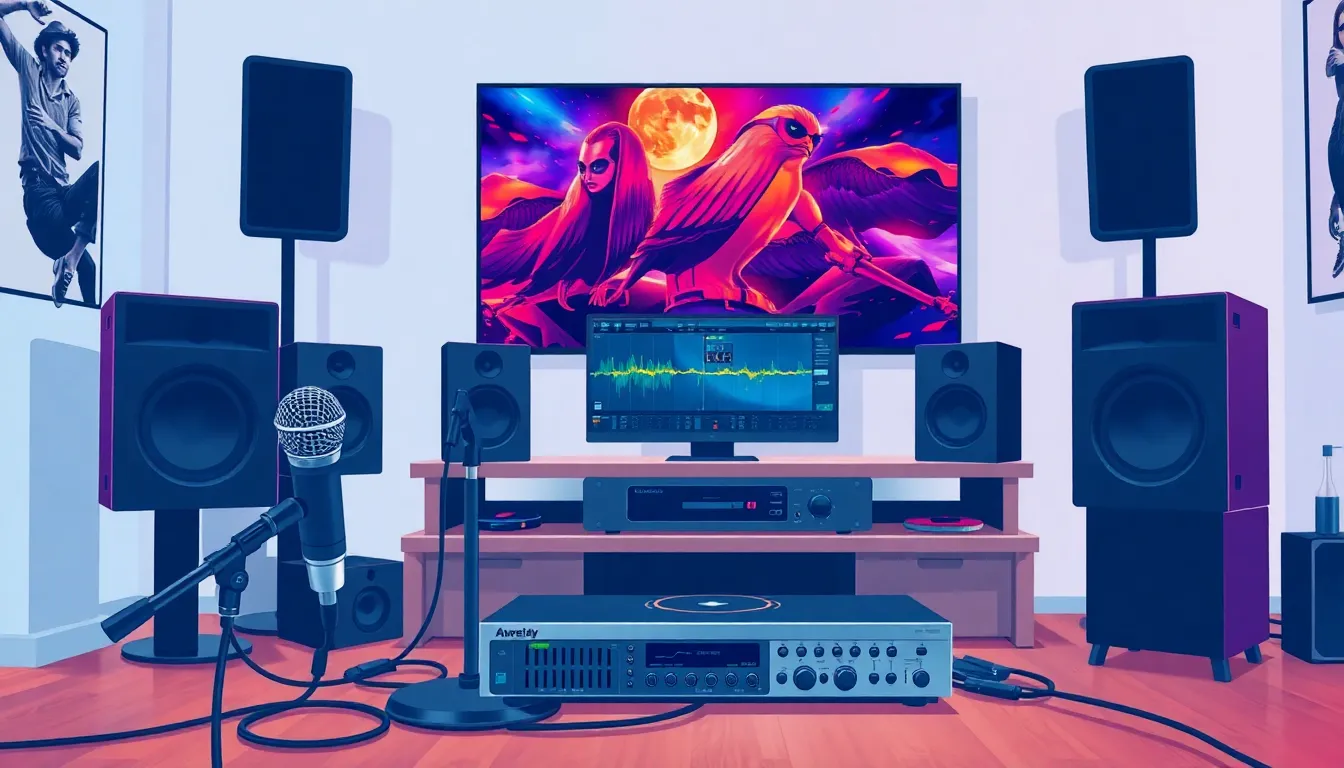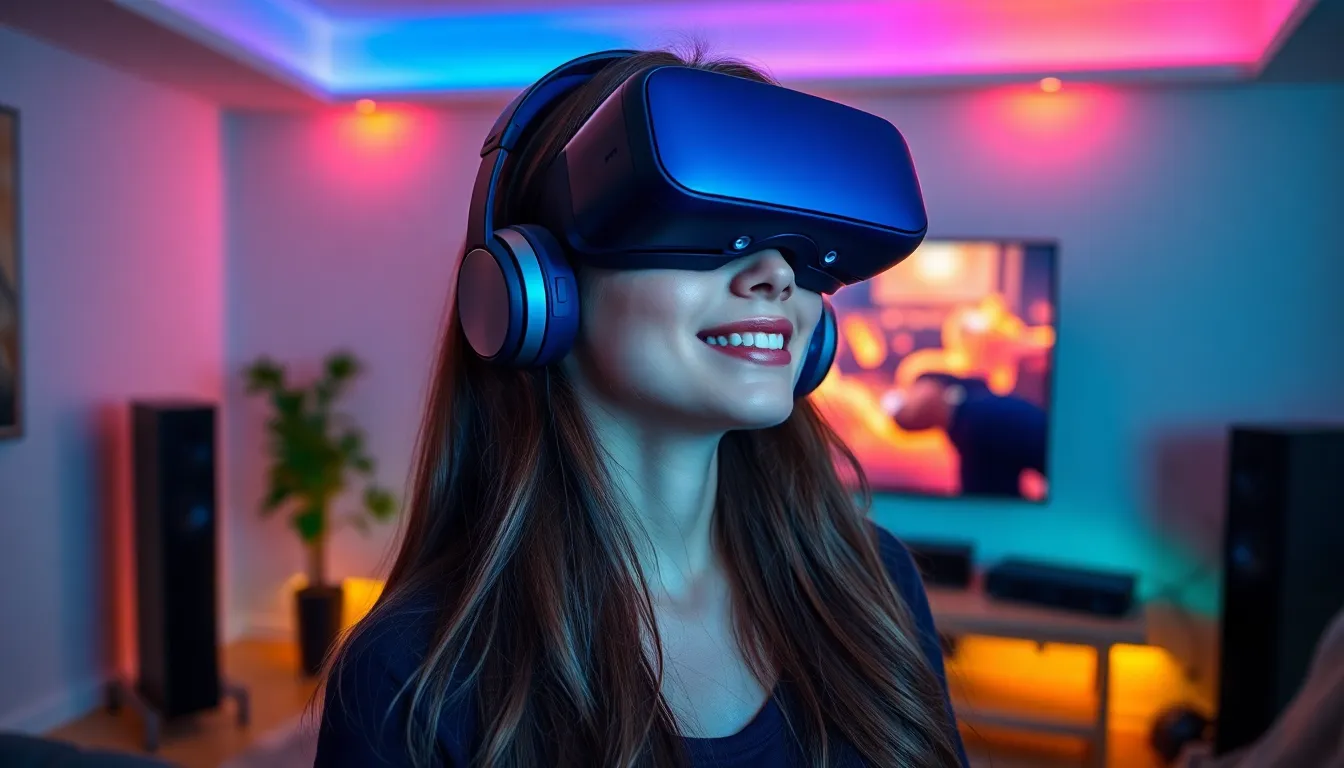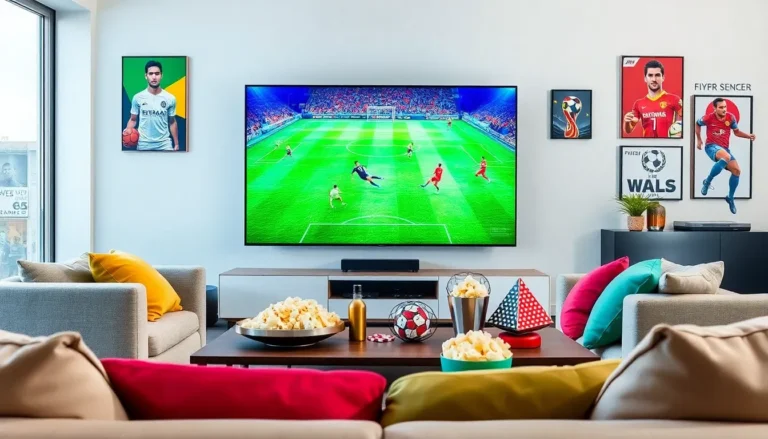In a world where binge-watching and podcasts reign supreme, audio and visual technology has become the unsung hero of everyday life. From the moment someone presses play, they’re transported into a realm where sound and sight collide in a spectacular dance. Whether it’s the latest blockbuster or a catchy tune that gets stuck in the head, these technologies weave magic that captivates audiences everywhere.
Imagine a life without crystal-clear sound or stunning visuals. It’d be like trying to enjoy a gourmet meal with a blindfold and earplugs—just not the same! As the industry evolves, it’s crucial to stay in the loop about the latest innovations that keep our screens glowing and our speakers booming. Buckle up as we dive into the fascinating world of audio and visual technology, where every pixel and note matters.
Table of Contents
ToggleOverview of Audio and Visual Technology
Audio and visual technology plays a crucial role in shaping the entertainment landscape. It encompasses various tools and systems designed to enhance the quality of sound and imagery. Advances in this field have transformed how audiences engage with media, whether through films, music, or online content.
High-definition audio equipment brings clarity and depth, allowing listeners to experience sound as if they are present. Visual enhancements, like 4K and 8K resolution displays, capture detail and vibrancy, creating immersive experiences. Technologies such as augmented reality (AR) and virtual reality (VR) further elevate user interaction, blending real and digital environments seamlessly.
Streaming services rely on audio and visual technology to deliver content efficiently. Users demand seamless playback; effective compression techniques and adaptive streaming technologies meet this need. These methods ensure optimal performance across various devices, whether it’s a smartphone, tablet, or smart TV.
Professional environments also benefit from advances in audio and visual technology. Conference rooms utilize high-quality video conferencing systems to enhance remote communication. Innovative microphones and speakers improve clarity during virtual meetings, fostering collaboration among teams.
The world of gaming showcases the evolution of audio and visual technology in a compelling way. Gamers seek realistic graphics and immersive soundscapes, pushing developers to innovate continually. The integration of spatial audio creates a multidimensional listening experience, allowing players to pinpoint in-game sounds accurately.
This interconnectedness of technology drives creativity and engagement across various media platforms. Understanding audio and visual technology, including its latest innovations, provides insights into the future of entertainment and communication. The ongoing advancements will undoubtedly shape how audiences consume content in the years to come.
Key Components of Audio and Visual Technology

Audio and visual technology consists of essential components that work in harmony to create immersive experiences. Understanding these components enhances appreciation for their impact on entertainment and communication.
Audio Technology
Audio technology encompasses various systems and devices designed to capture, process, and reproduce sound with clarity. Microphones convert sound waves into electrical signals, ensuring accurate recording during productions. Speakers play a crucial role by translating these signals into audible sound, facilitating a rich listening experience. Digital signal processors (DSPs) optimize sound quality by adjusting frequencies and dynamics for clearer audio output. Additionally, surround sound systems immerse users with multi-channel audio, elevating movie and gaming experiences. Products featuring spatial audio simulate realistic soundscapes, providing an engaging environment that captivates audiences.
Visual Technology
Visual technology includes devices and systems that enhance image quality and display resolution. High-definition (HD) displays offer sharper images, while 4K and 8K technologies provide even greater detail and clarity. Projectors deliver large-format visuals, essential for presentations and cinematic experiences. Virtual reality (VR) headsets immerse users in digitally created environments, merging entertainment with interactivity. Augmented reality (AR) overlays digital content on the real world, enriching user experiences during gaming and training. Furthermore, graphic processing units (GPUs) enhance rendering capabilities, ensuring smooth and vibrant visuals across devices. These advancements ensure that visual technology continues to shape how audiences engage with content.
Applications of Audio and Visual Technology
Audio and visual technology finds extensive applications across various fields, enriching experiences and improving interactions.
In Entertainment
Film production utilizes advanced audio systems and high-resolution visuals to captivate audiences. Streaming platforms depend on this technology to deliver seamless content anytime and anywhere. Gamers experience enhanced immersion with realistic sound effects and stunning graphics, which motivate developers to innovate continuously. Concerts leverage sound engineering to provide optimal audio experiences for live audiences. Virtual reality games immerse players in vividly detailed environments, making gameplay more engaging.
In Education
Classrooms incorporate multimedia tools to enhance learning and retention. Interactive presentations facilitate better comprehension of complex subjects through audio and visual aids. Online learning platforms engage students with a combination of videos, animations, and sound, catering to different learning styles. Virtual classrooms utilize video conferencing technology to maintain communication and collaboration among remote students. Augmented reality applications create immersive experiences that reinforce theoretical knowledge with practical demonstrations.
In Business
Video conferencing systems play a pivotal role in connecting teams across geographic boundaries. Clear audio and sharp visuals support effective communication and engagement during meetings. Presentations benefit from audio-visual elements that capture attention and enhance message delivery. Training sessions use immersive technologies to simulate real-world scenarios, improving skill retention. Marketing campaigns leverage high-quality video ads and sound to create emotional connections with audiences, driving customer engagement and sales.
Future Trends in Audio and Visual Technology
Immersive experiences shape the future of audio and visual technology. Augmented reality (AR) and virtual reality (VR) gain momentum, transforming how users interact with content. These technologies blend digital elements seamlessly with the physical world, creating interactive environments that enhance user engagement.
Increased adoption of 8K resolution signifies a major leap forward. This technology provides unprecedented detail, enriching the viewing experience. Advanced HDR (high dynamic range) expands the color palette, ensuring images come to life with vibrancy and depth. Moreover, spatial audio technology continues to develop, delivering sound that moves in three dimensions, further immersing listeners.
Artificial intelligence (AI) plays a critical role in content personalization. Streaming services utilize AI algorithms to recommend audio and visual content based on user preferences, enhancing user engagement. Additionally, AI enhances audio processing, improving quality and clarity, which elevates the overall listening experience.
Improved integration of audio and visual elements facilitates seamless user experiences. For instance, smart home devices allow users to control audio and visual systems with simple voice commands. Consequently, this technology simplifies interactions and makes it easier for users to enjoy their favorite content.
The rise of cloud-based platforms streamlines content delivery. High-speed internet accessibility enables seamless playback of high-definition audio and video across multiple devices. Businesses benefit from this shift, as remote work continues to be prevalent. Efficient communication through high-quality video conferencing systems strengthens collaboration and engagement.
Emerging technologies illustrate the constant evolution of the entertainment landscape. As advancements unfold, audio and visual technology will continue to redefine how audiences consume content. These trends signal a future where immersive, interactive experiences become the norm in both entertainment and professional settings.
Audio and visual technology is redefining how audiences engage with content across various platforms. As innovations continue to emerge the potential for immersive experiences grows exponentially. High-quality sound and visuals are no longer optional; they’re essential for captivating audiences in entertainment education and business.
The integration of AR and VR is pushing boundaries creating new ways for users to interact with their environment. With advancements in AI and cloud-based solutions the future looks promising for both consumers and creators alike. As these technologies evolve they’ll undoubtedly enhance the way people connect with content making every experience richer and more engaging.




